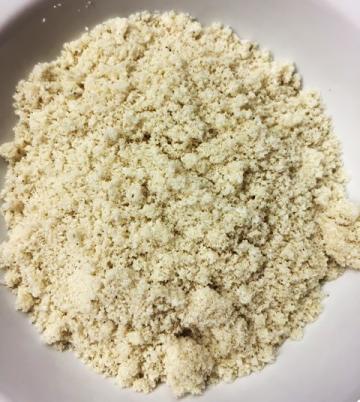Consumers Want More Catfish With Their Catfish
Adding Bone Powder to Breading Mix Increases Profits, Nutrition, and Sustainability

Catfish bones, dried and ground into powder. (Photo by Ryan Ardoin)
Commercial catfishing is big business in this country, but nearly 7 in 8 of those operations are considered small businesses; more than one-third have annual revenues of less than $25,000. The Agricultural Research Service (ARS) is trying to help them reel in more profits.
One of the ways they’re accomplishing that goal is turning what was once considered expendable – the fish’s bones, or “frames” – into value-added inventory.
According to Ryan Ardoin, food sensory scientist at the ARS Food Processing and Sensory Quality Research (FPSQ) unit in New Orleans, LA, people are eating more and more fish, and that’s a major contributor to food waste.
“Fillets are the most valuable part of catfish, and most of the other parts either go to waste or don’t make much money for producers,” Ardoin said. “Catfish bones are a safe source of calcium, so if we can find ways to keep these byproducts in the human food supply, they can provide valuable nutrients and increase profitability for the industry.”
Witoon Prinyawiwatkul, professor with the Louisiana State University Agricultural Center’s School of Nutrition and Food Sciences, is leading a collaborative project with FPSQ to bring this oft-overlooked resource to the attention of consumers and into the marketplace.
“When [we] introduce an unfamiliar food source to consumers, we need to find the most appropriate food products, so we ask consumers directly,” Prinyawiwatkul said. “If people aren’t willing to try the product, then the research isn’t practical and the benefits aren’t realized.”

Fried catfish strips made with 20% catfish bone powder in the breading mix. (Photo by Silvia Murillo)
Prinyawiwatkul’s survey found that most consumers (68%) were willing to try seafood byproduct in some form. They were most willing to try it if it was used as an ingredient in some other seafood or fish product. These results supported the use of catfish bone powder in fish fry mixtures.
“We used catfish bone powder in breading mixes, then used the mixes to coat fried catfish strips,” he explained. “The highest level we tested was 20% bone powder in the mix. Consumers liked these catfish strips as much or more than the control product using commercial breading without bone powder. In fact, 84% of consumers said they would purchase the fried catfish strips coated with bone powder mix and reported higher levels of positive emotions after learning of the added calcium.”
It might take a while for commercialization to take hold, Prinyawiwatkul said, but consumer studies show that people are increasingly willing to purchase foods made with seafood byproducts when they understand the benefits.
That added commercialization could improve human nutrition, increase the sustainability of fish farming, and help catfish farmers net greater profits. – by Scott Elliott, ARS Office of Communications
You May Also Like:

